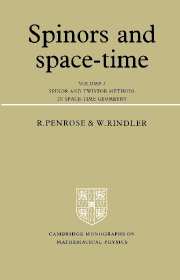Preface
Published online by Cambridge University Press: 23 December 2009
Summary
This is a companion volume to our introductory work Spinors and space–time, Volume 1: two-spinor calculus and relativistic fields. There we attempted to demonstrate something of the power, utility and elegance of 2-spinor techniques in the study of space–time structure and physical fields, and to advocate the viewpoint that spinors may lie closer to the heart of (even macroscopic) physical laws than the vectors and tensors of the standard formalism. Here we carry these ideas further and discuss some important new areas of application. We introduce the theory of twistors and show how it sheds light on a number of important physical questions, one of the most noteworthy being the structure of energy–momentum/angular momentum of gravitating systems. The illumination that twistor theory brings to the discussion of such physical problems should lend further support to the viewpoint of an underlying spinorial structure in basic physical laws.
Those who have some familiarity with the standard 2-spinor formalism should be able to read this volume as an independent work. All necessary background material has been collected together in an introductory section which summarizes the relevant contents of Volume 1. There are many references to this earlier volume in the present work for the results and notations that are needed, but these are all explicitly provided in the summary, the numbering of results being the same as that of Volume 1 so that they can be located in either place without ambiguity.
- Type
- Chapter
- Information
- Spinors and Space-Time , pp. vii - xPublisher: Cambridge University PressPrint publication year: 1986



